Facebook / Foursquare / website
Open: Mon-Thu 11-23h; Fri-Sat 11-24h; Sun 13-23h
Phone: +36 1 302 0024
Originally, I planned to blog about this teahouse later, but I like it so much that I simply couldn’t resist! Zöld Teknős Barlangja means Green Turtle’s Cave, by the way. This place is among the best when we’re talking about teahouses in Budapest; even the European Tea Association chose it to be the best European teahouse in 2008.
Zöld Teknős is ridiculously close to a teahouse I reviewed earlier, 1001 Éjszaka. Jókai street is packed with great places to enjoy tea in; later, we will visit here again to take a look at a teahouse called Potala a Palotához, a Tibetan place.
But on to approaching. Zöld Teknős is between Nyugati railway station and Oktogon, so you better set off from one of these squares. You can get to both either by tram (4/6) or by metro (3 if going to Nyugati railway station, 1 if going to Oktogon).
The entrance is easy to spot, as you can see. It portrays a huge totem pole, or at least the bottom of one. (Sorry for the bad quality pictures in advance. In my previous posts, I took photos with my iPhone; this time, I used a normal camera, and surprisingly, the results are worse. It was a bit late too, around five, six o’clock when I took the pictures.)
Upon entering, the first things customers see is the merchandise on the right side, (of which I will show you pictures later,) and the main counter. Here, a waiter will ask you if you’ve been here before, explain how you can order and where you can smoke a water pipe, and recommend a table. Behind the counter, a wide range of teas line up. These are for take-away only. You can take 50g and 100g packs with yourself, and the prices used to be listed in the menu. However, our waiter informed me that those prices increased lately, so you have to ask how much a certain dose of tea costs.
What I really have to emphasize are the decorations, because they are really impressive, and that this teahouse is huge. It has three levels: basement, ground floor, and a first floor. Each of these have their own specialty.
The basement’s entrance is in the other side of the teahouse. Above the staircase, a handsome Native American poses. Down there, you can find many seats – I think the basement is where the most tables are. It’s also where the second counter is located. The first counter is only used for welcoming customers and displaying the take-away selection. This one, however, is the one where they brew the tea; all orders are dispatched from here.
The ground floor, or where you get first after entering, may appear to be the smallest out of the three levels. Here, you can come in with a dog, as my friend Fruzsi and I did. You can see the separated part where we sat down on the above picture. This “room” is in front of the main counter and next to the entrance, so normally I wouldn’t recommend it because of its lack of relaxing atmosphere. But since Fruzsi brought her dog, Pami along, this was our only option. (By the way, if you have time, check out her/their blog, where you can find useful tips on how to train your dog in a city! You can find the link at the end of the post.)
Now, the most interesting part of the ground floor is the separes, located in a corridor, on the right side of the main counter. These are small separated rooms you can occupy for a certain fee per hour. Don’t worry; if you are in a separe, you can drink and eat the price of the fee. However, since the cheapest separe costs 3000 forints per hour, I would only recommend these if there is at least three of four of you. These smaller separes have room for at least two, at most six people. The medium ones usually have room for four to six people, and the biggest ones for eight to twelve people. The prices are 3000, 4000, 6000, and 8000 forints, the two latter concerning the biggest separes.
Unfortunately, I could only take a picture of the corridor most separes are located in; some of them were occupied and I didn’t want to disturb anyone. But I must mention that the separes come in different “styles”: Native American, western, Egyptian, Inca, knightly, African, and Arabic.
My favorite floor is the first floor. Here, there are two separes: a smaller (2-6 people) and a bigger (8-12 people) one, both in Native American style. The reason why these rooms and the whole floor are special is that this is the only place in the whole teahouse where you can smoke water pipes, aka. hookahs. Before the smoking regulation, customers could also smoke cigarettes in the separes; now, it’s only hookahs. The menu says that there’s a selection of twenty-seven shishas (tobacco used for water pipes), but do not believe that. I visited Zöld Teknős twice this week, the second time without a dog, so me and my friends who accompanied me requested a hookah. However, we could choose from five shishas only. Customers can choose from water pipes with one, two, and three tubes.
The menu is incredibly thick, containing an impressive variety of teas, snacks, and other beverages. (An online version is available, too; however, on this you cannot see what is not available anymore in the teahouse.) On the first pages, you can find information of the gifts you can get after spending a certain amount of money (more about this later); a list of the separes, their room capacity, style, and price; and food.
Unlike other teahouses, Zöld Teknős offers a wide selection of food and snacks. You can choose from six pates (pasties), salads, two seafood dishes, tortilla wraps, sausage dishes, cakes, sandwiches, toasts, muffins, cookies, dried fruits, nuts, sweet and salty snacks. The tea flavorings are also listed here; milk, cream, lemon, lemon juice, extra fruit, and four kinds of honey.
The tea blends all have fantasy names and small descriptions, as well as numbers. When ordering, you don’t have to say your choices name, but the number – the waiter will know which tea that is. The selection contains over three hundred blends, so you better take your time picking the most sympathetic one for you. The menu divides teas up to larger groups by type and flavor. I have to say that it’s a bit confusing, since you will find, for example, flavored black teas in the beginning and at the end of the tea section, too. You can find the following type of teas while skimming the menu: black, green, rooibos, and the flavored versions of these three; mate, fruit, wellness, herb, energy, dessert, chocolate, “foreign”, Ayurveda, Native American, white, and caffeine free.
Apart from teas, the menu offers a selection of soft drinks, coffee, hot chocolate, smoothies, and alcoholic drinks (including cocktails). Unfortunately, the menu is in Hungarian only, but all you have to do is to ask a waiter for help if you don’t understand something.
The above photo shows you the teas Fruzsi and me ordered when I visited the teahouse first this week, but I can’t remember the blend I got. The tea I ordered the second time way exceptional, however; I drank Weeki-Wachee, which is a blend of cherry, banana, raisin, pineapple, and hibiscus flower. I haven’t drunk a tea so banana-flavored in my entire life, so this blend quickly became one of my favorites.
You can call waiters by a button placed on/by/under every table – a really convenient method, if you ask me! The service is quick if we consider the size of Zöld Teknős; we got our order in ten, thirteen minutes. The amount of sugar served with our order was really small, and the amount of cream really big. (I really don’t know what they were thinking.) The cups were nice and we even got napkins, but the teapots are ridiculous. They would look really nice if there weren’t antitheft devices on each and every one of them. According to the menu, they can be bought for 25 000 forints, so I can almost understand the security. But it ruins the atmosphere.
For one teapot, you can get two cups, and one teapot’s worth of tea is enough for four cups.
There’s a lot more merchandise than in other teahouses, as well. Customers can buy teapots, cups, tea sets, containers, infusers, small sculptures, pictures, soap bars, and other small stuff like cheap Native American style bracelets and necklaces. The music heard in the teahouse can be bought in CDs (3000 forints), as well as the menu (5000 forints). You can also buy tea vouchers worth 3000, 5000, and 10 000 forints.
If you pay more than 3000, 6000, or 12 000 forints, you get a (really) small gift; and if you bet a totem card and visit the teahouse six times after, you can acquire a loyalty card which gives you 10% off your expenses.
Excuse me for the incredibly long post; there was a lot to cover. Overall, if you’re not a tight budget, come by Zöld Teknős, relax, and sip on quality tea. It’s worth a try.
For those of you who are interested in Fruzsi's dog training blog, click HERE and have an adorable picture of Pamacs!



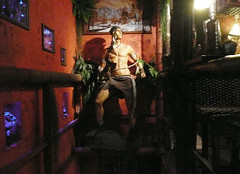



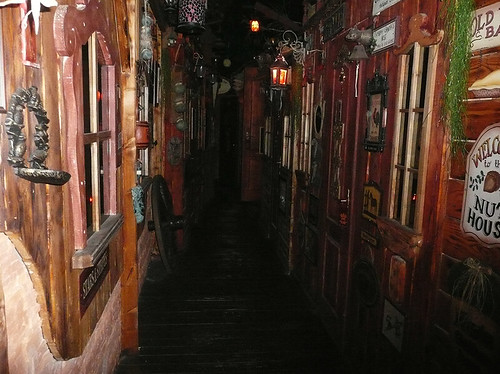


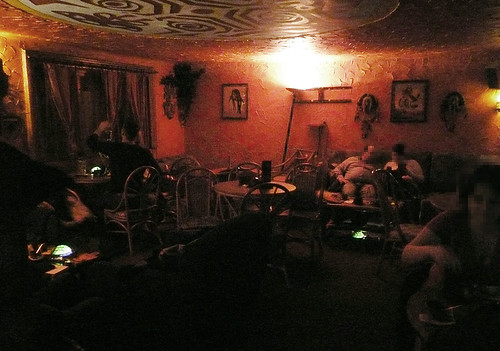


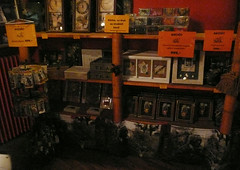
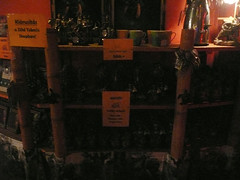




As an ardent tea drinker, I used to whine about the lack of teahouses in a city that appears to offer virtually limitless choices for those who are partial to coffee. Having read your reviews, I have to conclude that I was mistaken; Budapest may not have as many teahouses as coffee shops, but there are some nice tea places to visit.
ReplyDeleteI was wondering if there is any particular reason for the Native American theme in Zöld Teknős. Are the indigenous inhabitants of the Americas well known for their tea culture?
By the way, Pamacs is a real cutie.
I am glad that you found my blog helpful in terms of finding new places.
DeleteAs long as I know, Native Americans used different herbs to make medicine and tea, so that might be the source of Zöld Teknős's theme. Plus, Native American decorations are always a delight to look at, and the water pipes can be understood as "peace pipes". :) (Although I heard that those got banned in here, too. What a shame.)
(Sorry for the late reply.)